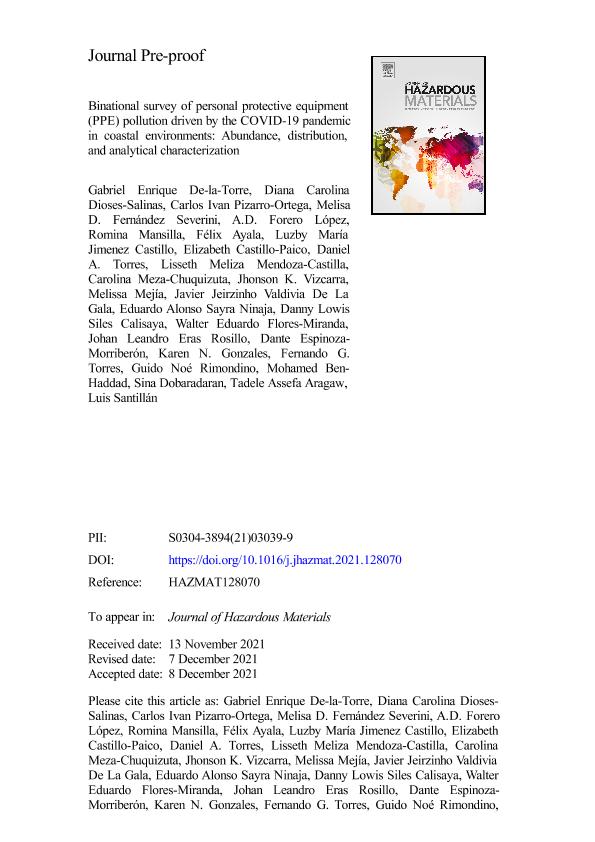Artículo
Binational survey of personal protective equipment (PPE) pollution driven by the COVID-19 pandemic in coastal environments: Abundance, distribution, and analytical characterization
De la Torre, Gabriel Enrique; Dioses Salinas, Diana Carolina; Pizarro Ortega, Carlos Ivan; Fernandez Severini, Melisa Daiana ; Forero Lopez, Ana Deisy
; Forero Lopez, Ana Deisy ; Mansilla, Paula Romina
; Mansilla, Paula Romina ; Ayala, Félix; Castillo Jimenez, Luzby María; Castillo Paico, Elizabeth; Torres, Daniel A.; Mendoza Castilla, Lisseth Meliza; Meza Chuquizuta, Carolina; Vizcarra, Jhonson K.; Mejía, Melissa; Valdivia de la Gala, Javier Jeirzinho; Ninaja, Eduardo Alonso Sayra; Calisaya, Danny Lowis Siles; Flores-Miranda, Walter Eduardo; Rosillo, Johan Leandro Eras; Espinoza-Morriberón, Dante; Gonzales, Karen N.; Torres, Fernando Gabriel; Rimondino, Guido Noé
; Ayala, Félix; Castillo Jimenez, Luzby María; Castillo Paico, Elizabeth; Torres, Daniel A.; Mendoza Castilla, Lisseth Meliza; Meza Chuquizuta, Carolina; Vizcarra, Jhonson K.; Mejía, Melissa; Valdivia de la Gala, Javier Jeirzinho; Ninaja, Eduardo Alonso Sayra; Calisaya, Danny Lowis Siles; Flores-Miranda, Walter Eduardo; Rosillo, Johan Leandro Eras; Espinoza-Morriberón, Dante; Gonzales, Karen N.; Torres, Fernando Gabriel; Rimondino, Guido Noé ; Ben Haddad, Mohamed; Dobaradaran, Sina; Aragaw, Tadele Assefa; Santillán, Luis
; Ben Haddad, Mohamed; Dobaradaran, Sina; Aragaw, Tadele Assefa; Santillán, Luis
 ; Forero Lopez, Ana Deisy
; Forero Lopez, Ana Deisy ; Mansilla, Paula Romina
; Mansilla, Paula Romina ; Ayala, Félix; Castillo Jimenez, Luzby María; Castillo Paico, Elizabeth; Torres, Daniel A.; Mendoza Castilla, Lisseth Meliza; Meza Chuquizuta, Carolina; Vizcarra, Jhonson K.; Mejía, Melissa; Valdivia de la Gala, Javier Jeirzinho; Ninaja, Eduardo Alonso Sayra; Calisaya, Danny Lowis Siles; Flores-Miranda, Walter Eduardo; Rosillo, Johan Leandro Eras; Espinoza-Morriberón, Dante; Gonzales, Karen N.; Torres, Fernando Gabriel; Rimondino, Guido Noé
; Ayala, Félix; Castillo Jimenez, Luzby María; Castillo Paico, Elizabeth; Torres, Daniel A.; Mendoza Castilla, Lisseth Meliza; Meza Chuquizuta, Carolina; Vizcarra, Jhonson K.; Mejía, Melissa; Valdivia de la Gala, Javier Jeirzinho; Ninaja, Eduardo Alonso Sayra; Calisaya, Danny Lowis Siles; Flores-Miranda, Walter Eduardo; Rosillo, Johan Leandro Eras; Espinoza-Morriberón, Dante; Gonzales, Karen N.; Torres, Fernando Gabriel; Rimondino, Guido Noé ; Ben Haddad, Mohamed; Dobaradaran, Sina; Aragaw, Tadele Assefa; Santillán, Luis
; Ben Haddad, Mohamed; Dobaradaran, Sina; Aragaw, Tadele Assefa; Santillán, Luis
Fecha de publicación:
03/2022
Editorial:
Elsevier Science
Revista:
Journal of Hazardous Materials
ISSN:
0304-3894
Idioma:
Inglés
Tipo de recurso:
Artículo publicado
Clasificación temática:
Resumen
In the present contribution, two nationwide surveys of personal protective equipment (PPE) pollution were conducted in Peru and Argentina aiming to provide valuable information regarding the abundance and distribution of PPE in coastal sites. Additionally, PPE items were recovered from the environment and analyzed by Fourier transformed infrared (FTIR) spectroscopy, Scanning electron microscopy (SEM) with Energy dispersive X-ray (EDX), and X-ray diffraction (XRD), and compared to brand-new PPE in order to investigate the chemical and structural degradation of PPE in the environment. PPE density (PPE m−2) found in both countries were comparable to previous studies. FTIR analysis revealed multiple polymer types comprising common PPE, mainly polypropylene, polyamide, polyethylene terephthalate, and polyester. SEM micrographs showed clear weathering signs, such as cracks, cavities, and rough surfaces in face masks and gloves. EDX elemental mapping revealed the presence of elemental additives, such as Ca in gloves and face masks and AgNPs as an antimicrobial agent. Other metals found on the surface of PPE were Mo, P, Ti, and Zn. XRD patterns displayed a notorious decrease in the crystallinity of polypropylene face masks, which could alter its interaction with external contaminants and stability. The next steps in this line of research were discussed.
Palabras clave:
MARINE
,
MASK
,
MICROPLASTIC
,
PLASTIC
,
SARS-COV-2
,
COVID-19
Archivos asociados
Licencia
Identificadores
Colecciones
Articulos(CADIC)
Articulos de CENTRO AUSTRAL DE INVESTIGACIONES CIENTIFICAS
Articulos de CENTRO AUSTRAL DE INVESTIGACIONES CIENTIFICAS
Articulos(IADO)
Articulos de INST.ARG.DE OCEANOGRAFIA (I)
Articulos de INST.ARG.DE OCEANOGRAFIA (I)
Articulos(INFIQC)
Articulos de INST.DE INVESTIGACIONES EN FISICO- QUIMICA DE CORDOBA
Articulos de INST.DE INVESTIGACIONES EN FISICO- QUIMICA DE CORDOBA
Citación
De la Torre, Gabriel Enrique; Dioses Salinas, Diana Carolina; Pizarro Ortega, Carlos Ivan; Fernandez Severini, Melisa Daiana; Forero Lopez, Ana Deisy; et al.; Binational survey of personal protective equipment (PPE) pollution driven by the COVID-19 pandemic in coastal environments: Abundance, distribution, and analytical characterization; Elsevier Science; Journal of Hazardous Materials; 426; 128070; 3-2022; 1-17
Compartir
Altmétricas



